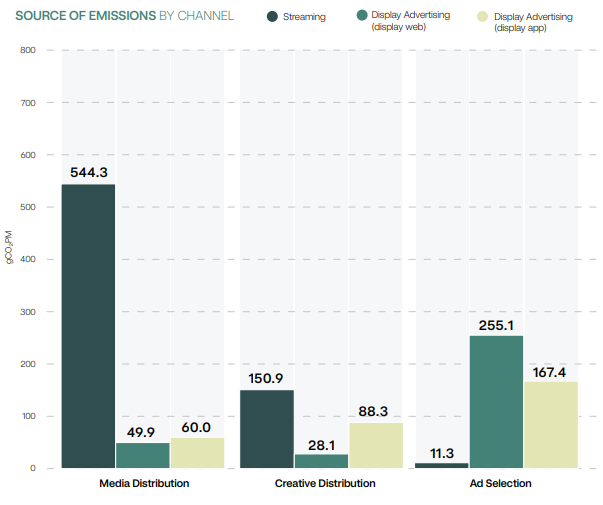Why connected TV risks repeating wasteful practices of adtech ‘explosion’

Scope3 has found streaming and display ads respectively produced 7.2 million metric tons of emissions every year.
Streaming ad emissions, from the likes Netflix and YouTube, was a new addition to Scope3’s quarterly State of Sustainable Advertising report, which previously only included findings on programmatic display advertising across desktop and mobile, both site, app, video and banner ads.
Most streaming ad emissions came from media distribution, nearly 10 times more than display web advertising and app advertising, with much lower emissions for creative distribution and ad selection.
Anne Coghlan, Scope3’s co-founder and chief operating officer, said: “Within connected TV or streaming video, there is an opportunity to put the brakes on the explosion of ad tech partners that we’ve seen in the display system, an opportunity to curb the wasteful practices of technology redundancies.”
She attributed streaming’s lower emissions from ad selection to “more closed ecosystems” or “more streamlined ways” to buy.
In total, streaming video ads emitted 3.4 million metric tons of emissions annually, while for display this was 3.8 million. Combined this is the equivalent of 1.4 million US households annual electricity usage.

The Scope3 report also now includes emissions data for the top 30 countries by volume of impressions (excluding China and Russia), compared to five in its inaugural report published in the previous quarter.
In terms of absolute emissions from advertising, the UK was third behind the US and India.
Looking forward, Coghlan said the quarterly emissions report will include audio, digital out-of-home and social, with at least two out of the three coming in the next quarterly study with the aim, in time, to have full coverage of the digital ecosystem with the ability to track overall reduction and useful information at a local market level.
Climate risk inventory delivers below average performance for advertisers
Coghlan told The Media Leader that in this report the aim was to “dive a little deeper” into data around climate risk inventory and Made for Advertising (MFA) sites, not just from a carbon perspective but also an advertiser effectiveness point of view.
She said: “There’s a deepening of our understanding that by focusing on reducing climate risk, lowering emissions, and not spending money on waste, an advertiser can actually also see better outcomes.”
Climate risk inventory was defined as “extremely high carbon domains, the worst emitting media properties” found online. MFA sites are a subset of this and inventory in this environment were found to have 26% higher carbon emissions than other sites.
Scope3 found climate risk can include up to 12- 14% of inventory in certain countries, and emissions from this inventory was on average twice the market average.
In a sample of anonymised and normalised post-campaign data, climate risk inventory underperformed by 13% on video completion rate and click-through rate. If this type of inventory was blocked from these campaigns, emissions would be decreased by 20% and performance would have gone up by 5%.
For MFA sites were “worse than average” for emissions and campaign performance, under-indexing in absolute performance by 30%.
Coghlan said that they saw “a significant correlation” between supply-side platforms that sell MFA inventory, and the amount of reselling.
She explained: “The more MFA inventory that a reseller has, the more reselling that there is on those domains which makes complete sense because if you run a MFA site, you’re trying to increase the bid density and maximise revenue at all costs, and so you really don’t care about issues of privacy, the number of players you’re bringing in, the latency or the user experience because probably significant proportions of your traffic are paid traffic anyway.”
In this edition of the State of Sustainable Advertising report overlaid attention, privacy and performance data on emissions data, finding a correlation between responsible media choices and campaign outcomes.
Coghlan said: “There were these real pockets of inventory that were not only better for the environment, but they were also better for an advertiser’s goals and performance, better from an attention perspective and better from a privacy perspective, too.”
The report found that nearly 10% of inventory was “optimal” across sustainability, performance, attention and privacy, which the report called a “win-win-win-win”.
Scope3 ran trials with the WFA at the end of April after its inaugural digital advertising emissions report and found that when focussing on carbon emissions there was either no impact to performance, or in many cases, an improvement in performance overall.
Coghlan said: “What I would love to see is sustainability not be put in its own separate column, but actually be brought into the conversations around what is effective and sustainable and responsible media buying.”



